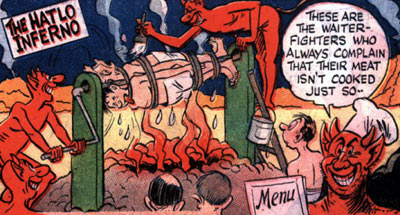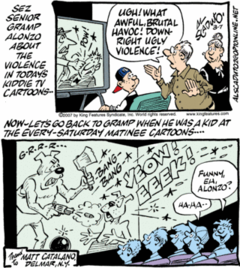
They'll Do It Every Time
Encyclopedia

Comic strip
A comic strip is a sequence of drawings arranged in interrelated panels to display brief humor or form a narrative, often serialized, with text in balloons and captions....
, created by Jimmy Hatlo
Jimmy Hatlo
James Cecil Hatlo , better known as Jimmy Hatlo, was an American cartoonist who created in 1929 the long-running comic strip and gag panel They'll Do It Every Time, which he wrote and drew until his death in 1963...
, which had a long run over eight decades. It first appeared on February 5, 1929 and continued until February 2, 2008. The title of the strip became a popular catchphrase, still used today by many people who have no idea of its origin. Hatlo, a sports cartoonist, created the panel to fill space on the comics page of the San Francisco Call-Bulletin. The feature proved so popular that it was eventually syndicated by King Features Syndicate
King Features Syndicate
King Features Syndicate, a print syndication company owned by The Hearst Corporation, distributes about 150 comic strips, newspaper columns, editorial cartoons, puzzles and games to nearly 5000 newspapers worldwide...
beginning in 1936.
Characters and story
The gags illustrated minor absurdities, frustrations, hypocrisies, ironies and misfortunes of everyday life. These were displayed in a single-panel or two-panel format. If two panels, the left-side panel showed some deceptive, pretentious, unwitting or scheming human behavior, with the second panel revealing the truth of the situation.
Topper (comic strip)
A topper in comic strip parlance is a small secondary strip seen along with a larger Sunday strip. In the 1920s and 1930s, leading cartoonists were given full pages in the Sunday comics sections, allowing them to add smaller strips and single-panel cartoons to their page.Toppers usually were drawn...
strip, The Hatlo Inferno, which ran with They'll Do It Every Time from 1953 to 1958. An occasional feature of They'll Do It Every Time was "Hatlo's History" which enabled the cartoonist to satirize memorable moments from earlier centuries.
In its early decades, a timid man named Henry Tremblechin was a recurring victim of the strip's observations. Tremblechin's bratty daughter, Little Iodine
Little Iodine
Little Iodine was a popular Sunday comic strip, created by Jimmy Hatlo, which was syndicated by King Features and had a long run from 1943 until 1985...
, appeared so often she graduated into her own comic strip (1943-86), comic book (1949-62), a 1946 movie and a 1988 animated cartoon show.
A tip of the Hatlo hat
Ideas and gags usually came from suggestions by readers, who were credited with a small acknowledgment box with a tiny drawing of Hatlo tipping his hatHat tip
A hat tip is an act of tipping or doffing one's hat as a cultural expression of recognition, respect, gratitude, greeting, or simple salutation and acknowledgement between two persons....
. Hatlo continued working on They'll Do It Every Time until his death in 1963 when the team of Al Scaduto and Bob Dunn
Bob Dunn (cartoonist)
Bob Dunn was an American cartoonist, entertainer and gagwriter who drew several comic strips.In addition to his own strips, Dunn was known for his work on Jimmy Hatlo's Little Iodine and They'll Do It Every Time.King Features syndicated Dunn's Just the Type from May 5, 1946 to November 24, 1963...
took over the strip. The readers continued to be credited for their suggestions, but the drawing of the "Hatlo hat" was dropped.
After Dunn's death in 1989, They'll Do It Every Time was written and drawn by Scaduto, who died December 8, 2007, at age 79. King Features announced that the strip would not continue with another cartoonist and ceased publication on February 2, 2008. At the time of Scaduto's death, King Features was distributing the panel to more than 100 American newspapers.
Awards

National Cartoonists Society
The National Cartoonists Society is an organization of professional cartoonists in the United States. It presents the National Cartoonists Society Awards. The Society was born in 1946 when groups of cartoonists got together to entertain the troops...
's Newspaper Panel Cartoon Award for 1968, 1969, and 1979 (with Al Scaduto), plus the Reuben Award for 1975. Al Scaduto won the Newspaper Panel Cartoon Award for 1991 and 1997 for his work on the strip.

